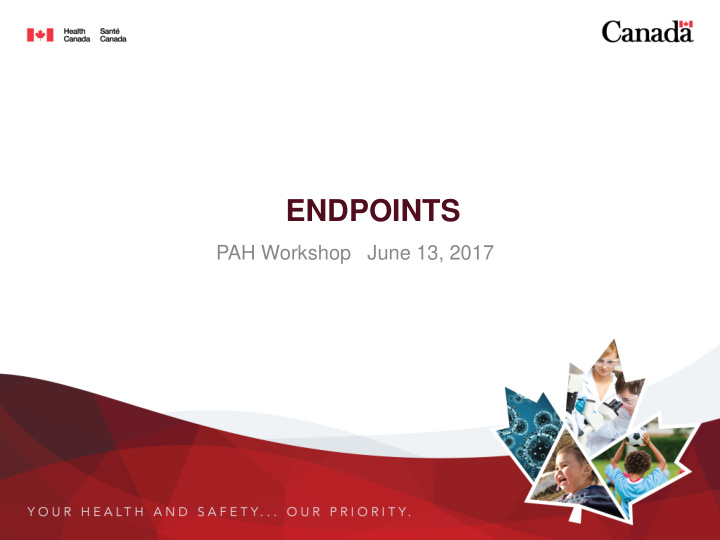



ENDPOINTS PAH Workshop June 13, 2017
OUTLINE • General overview • Consideration of endpoints for pediatric pulmonary hypertension trials
CLINICALLY MEANINGFUL ENDPOINTS • Endpoints that in themselves represent or characterize the clinical outcome of interest • Directly measure – A benefit that is detectable by the patient • How a patient feels, functions or survives – A decrease in the risk of developing a complication that can occur as a result of having the condition/disease
SURROGATE ENDPOINTS • Laboratory measurement or physical sign used as a substitute for a clinically meaningful endpoint • Ideally the surrogate endpoint exists within the therapeutic pathway of the intervention’ and therefore’ expected to reflect the clinically meaningful endpoint • Validation required • Benefit of using surrogate endpoint – May not be feasible to use direct endpoint • Very low event rates • Ethical reasons – Faster and easier – Less expensive
ENDPOINTS • PAH endpoints mainly validated for adults with IPAH • Traditional endpoints used in adults can be difficult/ not appropriate to assess in children • Need to define and measure endpoints that are clinically relevant to children
FUNCTIONAL ENDPOINTS ENDPOINT STRENGTH WEAKNESS General predictors of Growth catch-up may not occur Growth parameter child health (height, weight) Failure to grow is a sign of illness Predictor of survival Subjective patient self reporting New York Heart Convenience Poor for inter-trial comparisons Association Functional Ease of classification Poor detection of subtle changes Classification Widely used Not child oriented 5 age groups with Validation Panama Functional developmentally Complexity Classification appropriate criteria Time to complete
HEMODYNAMIC ENDPOINTS ENDPOINT STRENGTH WEAKNESS Measurement of right ventricular Invasive Cardiac catheterization structure/function Specialized centres Measurement of PAH Sedation/anaesthetic risk Non-invasive Strict compliance to study Echocardiogram Widely available protocol Not all information available in all patients with exception of septal position Measurement of cardiac structure Strict compliance to study Cardiac MRI and function protocol Sedation/anaesthetic risk
EXERCISE ENDPOINTS: ENDPOINT STRENGTH WEAKNESS Simple Lack of correlation with disease/ 6 minute walk distance Widely used treatment outcomes; test (6MDT) Influenced by physical characteristics of patient Ceiling effect Lack of validation for pediatric age, culture differences Ability to evaluate physiological Need of technical expertise Cardiopulmonary exercise severity Takes time to perform and for test Reproducible interpretation Lack of appropriate equipment for use in children Age limitations Simple device Validation Ambulatory physiological Real life data monitoring
LABORATORY ENDPOINTS: ENDPOINT STRENGTH WEAKNESS Sensitive to cardiac volume Not specific to disease Brain natriuretic peptide overload and increased wall Standardization of assay (BNP/ NT-pro BNP) stress Stability in transport?? Sensitive- impairment Not specific for disease or degree Serum uric acid of improvement Sensitive-impairment Not specific for disease or Renal function improvement (serum creatinine, creatinine clearance)
ENDPOINTS: PROs Strength weakness Assess a patient’s physical or emotional state Validation PROs Allow investigators to evaluate the effectiveness of a treatment and/or changes in the disease trajectory from a patient’s point of view
FACTORS TO CONSIDER IN CHOICE OF ENDPOINT • Will the endpoint be able to answer the study question? • Is the endpoint appropriate for the phase of the trial? • Is the endpoint appropriate for the population being studied? – age, culture, gender, etiology of PAH, degree of disability • What is the degree of change in endpoint required to be clinically meaningful?
Recommend
More recommend